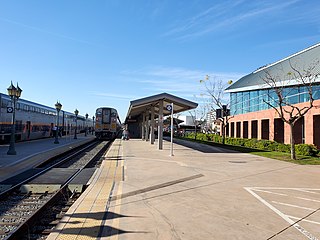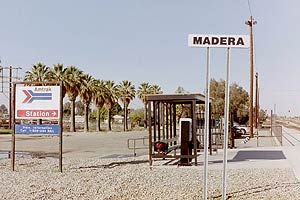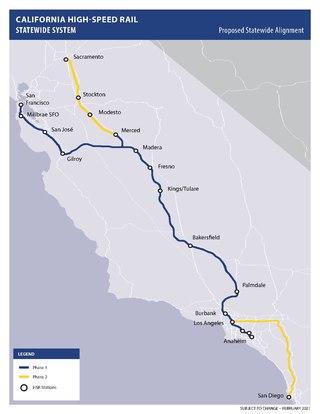
The San Joaquins is a passenger train service operated by Amtrak in California's San Joaquin Valley. Six daily round trips run between its southern terminus at Bakersfield and Stockton, with onward service to Sacramento and Oakland.

The Coast Starlight is a long-distance passenger train operated by Amtrak on the West Coast of the United States between Seattle and Los Angeles via Portland and the San Francisco Bay Area. The train, which has operated continuously since Amtrak's formation in 1971, was the first to offer direct service between Seattle and Los Angeles. Its name is a combination of two prior Southern Pacific (SP) trains, the Coast Daylight and the Starlight.

California High-Speed Rail (CAHSR) is a publicly funded high-speed rail system being developed in California by the California High-Speed Rail Authority. Phase 1, about 494 miles (795 km) long, is planned to run from San Francisco to Los Angeles and Anaheim via the Central Valley, and is partially funded and under construction. A proposed Phase 2 would extend the system north to Sacramento and south to San Diego, for a total of 776 miles (1,249 km). The project was authorized by a 2008 statewide ballot to connect the state's major urban areas and reduce intercity travel times. Phase 1 targets a travel time of 2 hours and 40 minutes from San Francisco to Los Angeles, compared to about nine hours on existing Amtrak service.

Amtrak California is a brand name used by the California Department of Transportation (Caltrans) Division of Rail for three state-supported Amtrak regional rail routes in California – the Capitol Corridor, the Pacific Surfliner, and the San Joaquins – and their associated connecting network of Amtrak Thruway transportation services.

Burbank Airport–South station, referred to as Hollywood Burbank Airport station by Amtrak and formerly known as Bob Hope Airport station, is an unstaffed Amtrak and Metrolink train station on the southeast corner of Hollywood Burbank Airport in the city of Burbank, California. Amtrak's Pacific Surfliner from San Luis Obispo to San Diego, Amtrak's Coast Starlight from Los Angeles to Seattle, Washington, and Metrolink's Ventura County Line from Los Angeles Union Station to East Ventura stop here.

Merced station is an intercity rail station located in Merced, California, United States. The station is served by seven daily round trips of the San Joaquins and is a transfer point between trains and Yosemite Area Regional Transportation System (YARTS) buses serving Yosemite National Park. Merced station has side platforms adjacent to the tracks of the BNSF Railway Stockton Subdivision.

Sacramento Valley Station is an Amtrak railway station in the city of Sacramento, California, at 401 I Street on the corner of Fifth Street, built in 1926 on the site of China Slough. It is the thirteenth busiest Amtrak station in the country, and the second busiest in the Western United States. It is served by four different Amtrak train routes and connecting Amtrak Thruway motorcoaches. It is also the western terminus for the Gold Line of the Sacramento RT Light Rail system and the Route 30 bus serving California State University, Sacramento.

Berkeley station is an Amtrak station in Berkeley, California, served by Amtrak California's Capitol Corridor service. The station is located under the University Avenue overpass just west of 4th Street. It is served directly by AC Transit bus routes 51B and 802; additionally, AC Transit Transbay routes FS, G, and Z stop nearby at 6th Street.

Antioch–Pittsburg station is an unstaffed Amtrak station in Antioch, California and is the closest station to Pittsburg, California, which is located about two miles (3.2 km) west. It is served by San Joaquins trains operating on the branch between Oakland and Bakersfield. The station opened on October 28, 1984, and has a single side platform serving the single track of the BNSF Railway's Stockton Subdivision. It is expected to close in 2024.

Bakersfield station is an intermodal facility in Bakersfield, California. It is the southern terminus of Amtrak California's San Joaquins route, with Amtrak Thruway buses continuing to Amtrak stations and bus stops throughout Southern California and Nevada. The station opened with a celebration on July 4, 2000. It contains an 8,300-square-foot (770 m2) train station with two platforms and three tracks, as well as a 17-bay bus station.

Newhall station is an intermodal hub in the Newhall neighborhood of Santa Clarita, California. The station is served by Metrolink's Antelope Valley Line operating between Los Angeles Union Station and Lancaster, Amtrak Thruway buses connecting to/from San Joaquins trains in Bakersfield, and serves as a transfer point in the City of Santa Clarita Transit bus system.

The Santa Fe Passenger Depot, also known as Fresno station, is an historic railroad station and transportation hub in downtown Fresno, California. It is served by San Joaquins inter-city passenger trains, Greyhound inter-city buses, and regional transit services including Fresno Area Express and the Fresno County Rural Transit Agency.

Robert J. Cabral Station, is a railway station in Stockton, California. In 2003, the station building was named in honor of the late Robert J. Cabral, a San Joaquin County supervisor instrumental in the creation of the Altamont Corridor Express (ACE), originally Altamont Commuter Express.

Lodi Transit Station, or simply Lodi station, is an intermodal transit facility in Lodi, California. It serves the San Joaquins rail line, is the hub for the local Lodi GrapeLine bus service and is also served by other intercity buses.

Storey was an unstaffed train station located in the unincorporated community of Storey, and about 1 mile (1.6 km) southeast of the Fresno River, in Madera County, California, United States. Just prior to its closure in November 2010 and replacement by the new Madera station, this station was served by Amtrak's San Joaquin. Prior to Amtrak, this station was also previously served by Atchison, Topeka and Santa Fe Railroad's (ATSF) San Francisco Chief and its Oakland-Barstow Line.

The construction of the California High-Speed Rail system is an undertaking by the California High-Speed Rail Authority. The project is expected to span about 800 miles (1,300 km) and will be completed in two phases:
Merced station is a proposed California High-Speed Rail station in Merced, California, located in Downtown Merced. The originally proposed site was to have been located at ground level on Martin Luther King Jr. Way near the interchange with Route 99/59, placing it about 7 blocks south from the existing Merced Amtrak station. The station was initially intended to be the northern terminus of the system's Initial Construction Segment. An alternative location for a fully elevated station proposed by the City of Merced and other stakeholders, 8 blocks to the west-northwest along 15th Street, between O Street and R Street was approved after a supplemental environmental review. The high-speed rail line will run on the south side of the Union Pacific Railroad right-of-way.

The California High-Speed Rail system will be built in two major phases. Phase I, about 520 miles (840 km) long using high-speed rail through the Central Valley, will connect San Francisco to Los Angeles. In Phase 2, the route will be extended in the Central Valley north to Sacramento, and from east through the Inland Empire and then south to San Diego. The total system length will be about 800 miles (1,300 km) long. Phase 2 currently has no timeline for completion.
Madera station is a proposed train station to serve Madera, California. It would be located near the intersection of Avenue 12 and Santa Fe Drive.

The Stockton Subdivision is a railroad line in the U.S. state of California owned by the BNSF Railway. It runs from the Port of Richmond, where trains interchange with the Richmond Pacific Railroad, to Fresno where the railway continues south as the Bakersfield Subdivision or the Union Pacific Fresno Subdivision. The line was originally constructed by the San Francisco and San Joaquin Valley Railroad in the late 1890s before being acquired by the Atchison, Topeka and Santa Fe Railway and becoming its Valley Subdivision. BNSF spent $17.5 million to upgrade track, bridges, and crossings along the line in 2005.





















